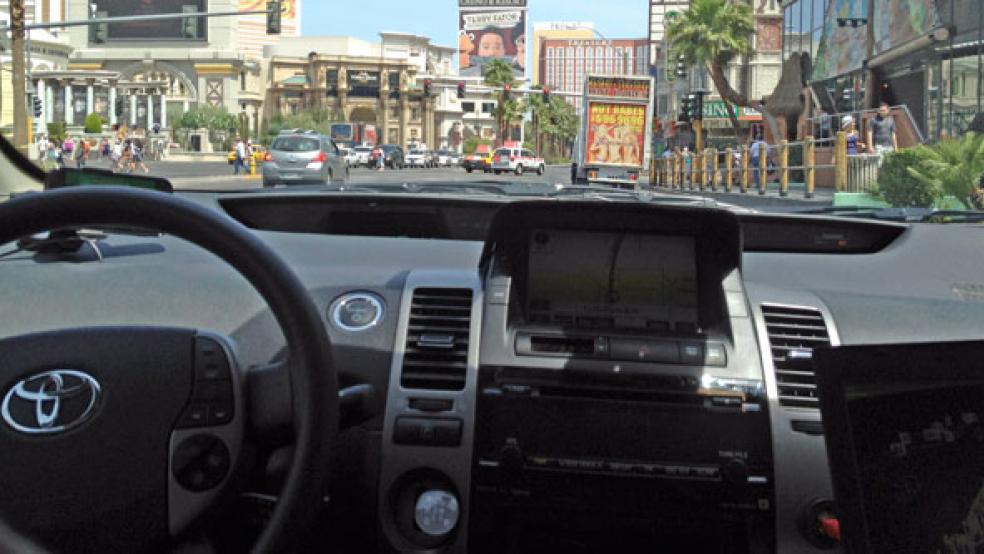Once only seen on futuristic television shows like "The Jetsons," self-driving cars could park themselves in your garage – and do a whole lot more – sooner than you think.
As automakers begin to equip cars with technologies that take control from the driver, it's not unrealistic to expect self-driving cars to hit the market within the next decade. The state of Nevada recently granted Google a license to test its self-driving car on public streets. Tomorrow, the Department of Transportation will kick off a program to pilot-test 2,800 connected vehicles in Ann Arbor with communication devices that allow them to talk to each other and avert accidents on their own. A recent report by The Center for Automotive Research and KPMG concludes that self-driving cars for consumers are inevitable – it only depends on how quickly the country can adopt the technology and infrastructure.
RELATED: Your New Car – Smaller, Safer, and Smarter than You
Autonomous driving allows the driver to take his hands off the wheel and have the car drive from one destination to the next without being involved in the car's operations. Automakers and safety regulators believe that autonomous cars don't just provide convenience for drivers; they offer the promise of dramatically reducing collisions, as cars are equipped with sensors that warn when a car or other obstacle is dangerously close and automatically avoids the object.
J.D. Power and Associates' 2012 Emerging Technologies Study found that 37 percent of drivers are interested in owning an autonomous vehicle, as long as the cost isn't significantly higher; 20 percent of vehicle owners say they likely would purchase a self-driving car even after learning the additional cost could be $3,000.
While some drivers in the survey expressed concern about ceding control to their car, many felt it would free them up to spend the often arduous time behind the wheel in pursuits they enjoy, said Mike VanNieuwkuyk, executive director, global automotive, for J.D. Power. VanNieuwkuyk added that such vehicles will "open up the world for people" who currently can’t drive, like the handicapped and blind, while assisting the burgeoning group of older boomers who will undoubtedly suffer disabilities as they age.
There is a downside, however. If the vehicle can drive itself, park itself, and ultimately refuel itself, why employ taxi or bus drivers? Why not operate all urban vehicles that serve the public from a central command station?
RELATED: 8 Incredible Cars Driven by the World’s Richest People
Autonomous driving will be achieved in phases, with many automakers beginning to implement technologies like forward collision and lane departure warnings, that alert the driver if he’s about to hit another car, then take more active control if the driver ignores the warnings. The concept "will be introduced very slowly to show that it works and it's safe," says Bruce M. Belzowski, assistant research scientist at the University of Michigan's Transportation Research Institute, with features likely starting out in premium vehicles.
Much still needs to be done from a regulatory and government side to deal with autonomous cars on the road, says Nady Boules, director of the electrical and control systems research lab at General Motors. "We're all convinced it's technically feasible. It's a matter of commercializing the technology and making it affordable and robust enough for customers," he said.
GM, for example, is focusing on active safety and driver assistance systems that will be the building blocks for autonomous cars. Boules expects the technology to be ready in the next decade, but it may not be implemented on a wide scale until 2020 to 2030. Ford has included many driver assist technologies in its 2013 Ford Fusion and Explorer vehicles, including lane-keeping systems that alert the driver if he’s driving out of the lane, an alert system to warn drivers when they're becoming drowsy, and a blind spot indicator system.
"You'll see those technologies continue to evolve to add more automated capabilities," including the ability to offer some auto pilot in certain situations, said Alan Hall, a Ford spokesman. For example, he says a technology in the research phase called traffic jam assist – due in five years – allows the car to manage driving itself in a stop-and-go traffic jam situation, controlling the gas, brakes and steering. William Ford's February 2012 "Blueprint for Mobility" predicts full-scale autonomous driving beginning in 2025, while some level of deployment will occur within the next five to 10 years.
The main challenge in making self-driving cares mainstream, in addition to ensuring they're economical, is that of liability if something breaks or there is an accident, says David Cole, chairman emeritus of the Center for Automotive Research. Given our litigious society, he says the vehicles will have to be deemed foolproof before they can be given the green light in great volume.
John O'Dell, a senior editor for fuel efficiency and green cars for Edmunds.com, expects to see self-driving cars for consumers within 10 to 15 years – but says it could be many years beyond that before society is actually ready to allow the cars on the streets. He points out that Nevada merely said it was not illegal to test the Google car, but that licensing the cars for the masses will be a much larger hurdle. "They need to develop motor vehicle codes that govern its use and recognize it isn't a driver" controlling the vehicle, he said.




